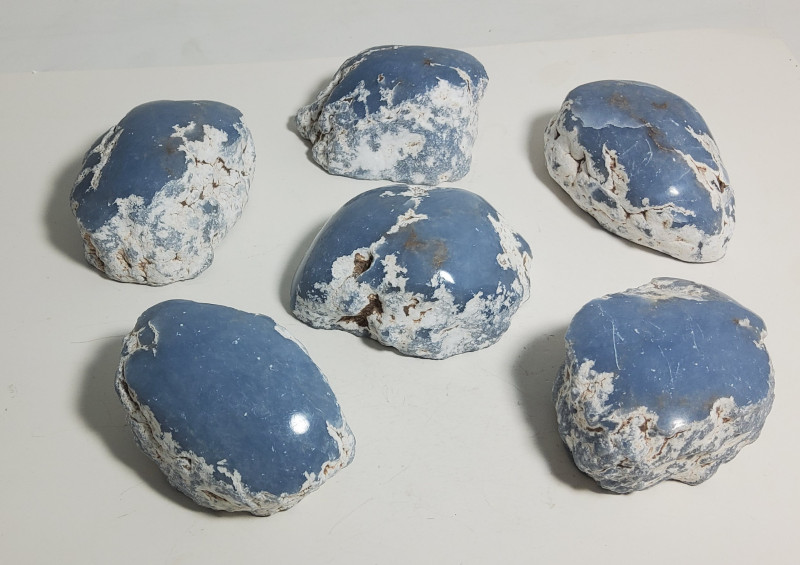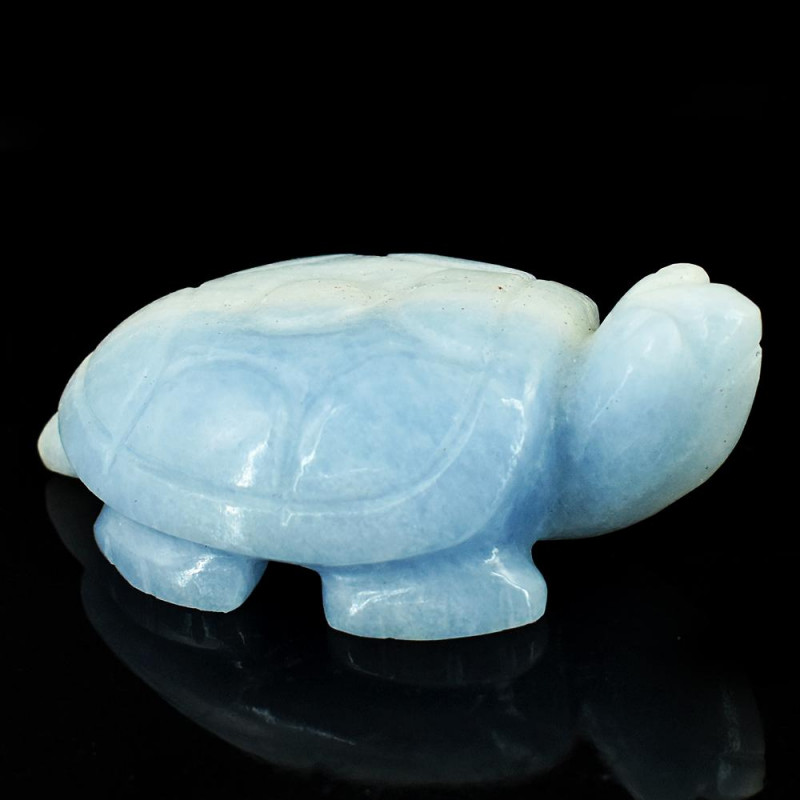
アンハイドライト(エンジェライト)宝石:特性、意味、価値ガイド
 無水石は淡い半透明の結晶で、エンジェライトとも呼ばれます。無水石は宝石でしょうか?もちろんです!ただし、ファセットカットのジュエリーよりも彫刻でよく見かけます。
無水石は淡い半透明の結晶で、エンジェライトとも呼ばれます。無水石は宝石でしょうか?もちろんです!ただし、ファセットカットのジュエリーよりも彫刻でよく見かけます。
ところで、無水石は珍しいのでしょうか、それとも一般的なのでしょうか?鉱物としては比較的一般的ですが、容易に別の鉱物に変化するため、見つけるのは困難です。宝石質の無水石は非常に希少です。
無水石の色は?通常、販売されている結晶や宝石は、氷河のような青やライラック色で、雪のような斑点が散りばめられています。透明なものは、無色や紫色の場合もあります。半透明のものは、白、黄褐色、灰色、ローズ、ライラック色などがあります。
無水石のジュエリーをお探しですか?このガイドでは、無水石の選び方、ヒーリング効果、意味、価格などについて詳しく解説しています。

無水石について
無水石は淡い色合いの半貴石です。「エンジェライト」を同義語と考える人もいますが、ペルー産の青みがかった灰色の無水石の一種と考える人もいます。
変種として言及される場合、エンジェライトは「ブルーアンハイドライト」と呼ばれることもあります。この記事では、広義ではアンハイドライトの同義語として「エンジェライト」を使用しますが、宝石の詳細について論じる際には変種名として「アンハイドライト」を使用します。
占星術的に、このクリスタルは水瓶座の星座石です。水瓶座にとって、エンジェライトの効能は、緊張や頑固さを和らげ、共感と心の平穏をもたらすことです。
占星術や宝石としての利用以外では、無水石膏はどのような用途に使われますか?無水石膏の工業用途には以下が含まれます。
ワニス、セメント、塗料、石膏の乾燥添加剤
壁板および漆喰の原料(石膏を含む)
硫酸を作るための硫黄の供給源
土壌処理剤に含まれるカルシウムが豊富な成分(粉砕時)
無水石膏の工業用途の多くは石膏と共通しています。実際、土壌処理においては無水石膏の方が石膏よりも優れています。水分を含まないため、より多くのカルシウムを供給できるからです。しかし、化学的には、この2つの石は実質的に兄弟のようなものです。
 上の写真:亜セレン酸石膏
上の写真:亜セレン酸石膏
無水石膏と石膏
無水石膏はよく別の鉱物に変化すると言いましたよね?その鉱物とは石膏です!
石膏は水を加えると無水石膏と同じ組成になります。そのため、無水石膏は濡れると石膏に変化します。逆に、石膏が脱水すると無水石膏に変化することもありますが、自然界ではあまり一般的ではありません。
無水石膏と石膏は両方とも白色であることが多く、白い縞とガラスのような光沢があります。
ただし、無水石膏と石膏の間にはいくつかの重要な違いがあります。
希少性: 石膏は無水石膏よりもはるかに一般的です。
硬度: 石膏は無水石膏 (3-3.5) よりもわずかに柔らかい (モース硬度 2)。
水分含有量: 前述のとおり、石膏には水分が含まれますが、無水石膏には含まれません。
注目すべきは、「精製石膏」と呼ばれる粉末は実際には無水(水を含まない)であり、約30%のカルシウムと23.5%の硫黄で構成されています。参考までに、純粋な石膏には約23%のカルシウムと約19%の硫黄が含まれています。
鉱物の特性といえば...

無水石膏の仕様と特徴
無水石膏は硫酸カルシウムで、化学式はCaSO4です。無水石膏の結晶には水分が含まれていますか?いいえ、無水石膏は「無水」です。これはギリシャ語の「 anhydros (水のない)」に由来しています。それがこの名前の由来です。
その名の通り、この石は非常に繊細です。非常に柔らかく、 モース硬度はわずか3~3.5です。さらに、3方向に容易に割れるため、どの角度からでも鋭い衝撃を受けると、宝石は粉々に砕け散ってしまいます。
実際、無水石には「キューブ・スパー」という別名があります。この呼び名は、石の90度の劈開角が割れ、内部に立方体のような形状が現れることに由来しています。しかし、無水石は立方晶系ではなく斜方晶系です。
鉱物の結晶は厚く、柱状、または板状(薄く、4面体)です。多くの場合、硬石膏は繊維状の脈として形成され、劈開に沿って破片に砕けます。また、球状(球根状の表面を持つ丸みを帯びた塊)、塊状、または粒状の塊を形成することもよくあります。
残りの無水石膏鉱物の特性は次のとおりです。
モース硬度:3~3.5
色: 透明な石 - 無色、水色、または紫色。半透明から不透明な石 - 白、黄褐色、灰色、バラ色、または藤色
結晶構造:斜方晶系
光沢: [010]では真珠光沢、[001]ではガラス質から油状、[100]ではガラス質。塊状の変種 - ガラス質(ガラス状)
透明性:透明から不透明
屈折率:1.57~1.61
密度:2.9~3.0
へき開:完全、3方向、対称面に平行
骨折:不均一、裂片状、または貝殻状
縞模様:白
発光: 加熱すると蛍光を発することがある。ドイツの素材は長波紫外線で赤色に蛍光を発する。
多色性:紫色の結晶に存在 - 紫、ライラック/ローズ、淡黄色/無色

無水石膏の種類
無水石には3つの種類があり、必ずしも品種名とは限らない商標名が付けられていますが、この宝石を購入する際には知っておくことが重要です。また、エンジェライトとセレスタイトの違いについてもご説明します。
エンジェライト

エンジェライト(アンジェリン、エンジェルストーンとも呼ばれる)は、不透明な空色、灰青色、またはライラック色の無水石英の商標です。白い斑点が見られることが多く、濃い赤から茶色の斑点が見られる場合もあります。
腸結石
「腸石」とは、あまり天上的な意味を持たない呼び名ですが、硬石膏が襞になった(密集した)塊のことを指します。襞は、人体の腸の襞に似ています。牛の胃の内壁がトリプと呼ばれることから、このねじれた結石は「トリプ石」と呼ばれることもあります。
ヴルピナイト
ヴルピナイトは、イタリアのヴォルピーノ産の白っぽい灰色の硬石膏です。粒状で鱗状でありながら、大理石のような質感をしています。地元ヴォルピーノで特に人気があります。
青い「エジプト」無水石膏
 画像提供: アイペイント(コール)の瓶とスタンド、紀元前1878年~1749年頃|メトロポリタン美術館
画像提供: アイペイント(コール)の瓶とスタンド、紀元前1878年~1749年頃|メトロポリタン美術館
青色の「エジプト」無水石膏は、最も謎めいた種類です。古代エジプト人は装飾用に白色の無水石膏と研磨された青色の無水石膏の両方を使用していましたが、青色の素材がどこから入手されたのかは未だに解明されていません。
エンジェライト vs. セレスタイト
セレスタイト、またはセレスチンは、一般的に透明から淡い青色の結晶です。つまり、エンジェライトと似たような神秘的な名前と外観を共有しているということです。
でも、セレスタイトとエンジェライトは同じものなのでしょうか?いいえ。どちらも斜方晶系で、透明から半透明で、モース硬度は3~3.5ですが、全く異なる鉱物です。
エンジェライト(無水石膏)とセレスタイトの違いは何ですか?
成分: エンジェライトは硫酸カルシウム、セレスタイトは硫酸ストロンチウムです。
密度: エンジェライトの密度はセレスタイト (3.9-4.0) よりも低く (2.9-3.0) なっています。
違いはあるものの、エンジェライトの意味はセレスタイトの意味と非常に似ています。
 画像クレジット: 額にガゼルの頭を乗せたホルスの横顔を描いたミニチュア・キッポス(魔法の石碑)MET DP112604 |メトロポリタン美術館
画像クレジット: 額にガゼルの頭を乗せたホルスの横顔を描いたミニチュア・キッポス(魔法の石碑)MET DP112604 |メトロポリタン美術館
無水石膏の意味と歴史
「意識の石」の異名を持つエンジェライトは、愛、光、そして霊的な意識を象徴しています。この石は天使から人類に贈られたと信じられており、「天使との繋がりの石」という別名も生まれています。
しかし、無水石の水晶の精神的な意味は、すべてが雲の中にあるというわけではありません。バランスをとる能力があり、精神が舞い上がり、探求している間、あなたを地に足をつけさせてくれると信じられています。
歴史
無水石膏の用途は古代にまで遡ります。古代エジプトでは、白と青の無水石膏が装飾品や装飾品を作るのに人気がありました。例えば、現在ブルックリン美術館に収蔵されている、紀元前1938年から1700年頃のアイメイク用のコールを入れる壺などがその例です。
無水石膏は1794年、オーストリアのハル岩塩鉱山で初めて発見されました。石膏は地表(地下水付近)に近かったのに対し、無水石膏はより深部で発見されました。ドイツの地質学者アブラハム・ゴットロープ・ヴェレナーは1804年にこれを「無水石膏」と名付けました。
廃れた名前の一つにムリアサイト(muriacite)がありますが、これは塩化物(または塩化物)鉱物であるという誤った考えに由来しています。
20世紀における無水石膏の顕著な例として、イギリスの彫刻家オフィーリア・ゴードン・ベルの彫刻が挙げられます。ベルは、ユナイテッド・サルファリック・アシッド・コーポレーションの委託を受け、無水石膏で作られた無水石膏窯のレリーフ彫刻を制作しました。
エンジェライトの発見
アメリカの宝石学者ジョン・イルマリ・コイヴラとR.C.カマーリングは、ずっと後になってエンジェライトを発見しました。エンジェライトは、1987年にペルーのマチュピチュで行われた世界平和のための瞑想イベント「ハーモニック・コンバージェンス」で発見されました。
このイベントは、8つの惑星が「グランドトライン」を形成するという稀有な(そして現実の)一直線上に並ぶという、超自然的な予言と時を同じくして企画されました。(ハンズ・アクロス・アメリカをイメージしてください。ただし、占星術と世界的な参加がより多く含まれています。)
エンジェライトのスピリチュアルな意味の多くは、この出来事での発見に結びついています。ところで、エンジェライトは何に効果があるのでしょうか?

無水石膏の治癒特性
宝石の色は、そのヒーリングストーンとしての特性に影響を与えることがあります。無色から白色の無水石は、白色の宝石と同様に、浄化作用、知性を高める作用、そして清浄作用を持ちます。
エンジェライトのような青い宝石は、心を落ち着かせ、コミュニケーションを促進するのに最適です。そのため、エンジェライトのチャクラストーンは喉のチャクラを開き、真の自己理解と表現を促します。
身体的および感情的な癒しのために、無水石膏の結晶はどのような効果がありますか?
身体の治癒
クリスタルヒーラーは無水石膏を以下の目的で使用します:
喉の感染症
心臓と循環器系の問題
頭痛
免疫システムの機能
甲状腺の問題
集中力の問題
感情的な癒し
感情面では、無水石膏の効能は次のことを促進します。
自己認識
心の平安
自己表現
目的意識
さらに、このクリスタルは怒りや不安を消し去り、受け入れ、共感、そして自己理解へと導くと言われています。マインドフルネスと今この瞬間を生きる力を与えてくれると言われています。

無水石英宝石の特性
無水石の客観的な価値は、その色、カット、透明度、透明性によって決まります。
色
無水石はほとんどの場合、柔らかく淡い色合いをしています。最も価値の高い色は、ピンク、バイオレット、またはブルーの色合いです。
エンジェライトの中心にある白い斑点や斑点は、石膏や石英の内包物によるものです。一方、錆色や茶色の斑点はヘマタイトによるものです。より濃い色合いは、エンジェライトの価値を下げる可能性があります。
カット
無水石は希少で精密なカットが難しいため、 ファセットカットされた無水石はあまり一般的ではありません。ヴルピナイトとエンジェライトはカボションカットされることが多いですが、エンジェライトは彫刻されるのが最も一般的です。ペルー産のエンジェライトの彫刻は、動物の置物や杖、卵や球体など多岐にわたります。
明確さと透明性
クラリティは宝石に含まれる目に見える内包物の数を表すため、透明度に影響します。透明度が高く、クラリティの高い無水石はより価値があります。
無水石膏によく見られる内包物には、連晶結晶や多相空洞、あるいは異なる形態(液体、固体、蒸気)の内包物を含む領域などがあります。

無水石膏の形成と供給源
無水石膏は蒸発岩の一種で、海底または海底以外の堆積物から水が蒸発して形成される堆積鉱物です。通常、この鉱物は石膏から始まり、その後脱水して無水石膏になります。
この鉱物は、堆積岩、火成岩、岩塩ドームの頂部、岩塩盆地に産出します。石膏層、石灰岩層、または玄武岩の空洞の周囲に多く見られます。
採掘場所
無水石膏はどこで採掘されますか?オーストリアとペルーの初期の産地に加え、現在では以下の産地からも無水石膏が採掘されています。
英国
エジプト
ドイツ
リビア
メキシコ
ポーランド
アメリカ合衆国(ニューヨーク)

無水石膏の価格と価値
希少性にも関わらず、無水石は手頃な価格で入手できます。
無水石カボションの卸売価格は1カラットあたり約0.10ドルです。彫刻作品は職人の技量とサイズによって異なりますが、一般的に1つあたり5ドルから40ドル程度です。アンジェライト原石の価格は1カラットあたりわずか0.02ドルから0.10ドルです。
ビーズで作られたエンジェライトのブレスレットは通常5ドルから30ドルですが、中には60ドルほどするものもあります。エンジェライトのペンダントは販売者によって5ドルから90ドル、ビーズで作られたネックレスは60ドルから150ドルと少し高価です。
お気に入りを見つけたら、エンジェライトをどのように手入れしますか?
無水石膏のケアとメンテナンス
無水石は、適切な宝石ケアが極めて重要です。まず、水分を素早く吸収しやすいため、湿気や湿気から遠ざける必要があります。さらに、その柔らかさと完璧な劈開性により、傷や破損が生じやすい性質があります。
ダメージを避けるため、無水石のイヤリングまたはネックレスのみをご使用ください。ビーズの連珠の場合は、ビーズとビーズの間にしっかりとした結び目や保護が施されている必要があります。無水石のジュエリーは必ず保護セッティングが施されたものをお選びください。
汗による湿気を防ぐため、ネックレスは肌に直接つけるのではなく、布の上から着用するのがおすすめです。柔らかく、ほこりのない乾いた布で拭いてください。

自分だけのエンジェルストーンを手に入れよう!
無水石は、多くの人にとっては比較的現代的な石ですが、今では天空の石として崇められています。この希少な石は、新たなチャンスが訪れる澄み切った空を映し出し、ありのままの自分を受け入れ、地に足をつけ、一瞬一瞬を心から楽しむ力を与えてくれます。
Gemstone Encyclopedia検索
最新記事
ヤシ象牙彫刻は、植物象牙とも呼ばれ、南米のヤシ科植物フィテレファス属のヤシの実から倫理的に採取された、象牙の天然代替品です。このガイドでヤシ象牙についてすべて学びましょう!
15th Jan 2026
レインボーラティスサンストーンは、様々な内包物によって3つのゴージャスな光学的効果を持つ長石の一種です。燃えるように鮮やかな色合いと格子模様が、コレクターにとって希少な宝石となっています。
12th Jan 2026
記事のカテゴリ
How To's is where you will find helpful articles from gem Rock Auctions on how to cut gemstones, select gemstones and buy gemstones.
9記事数
